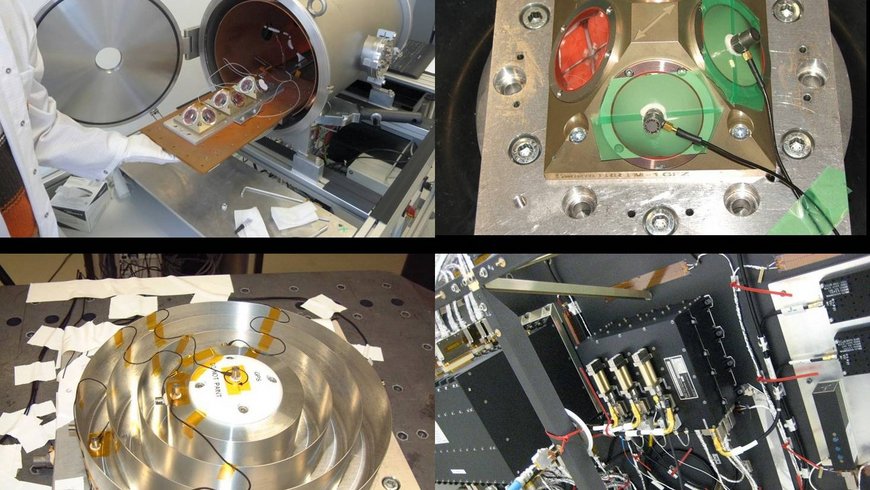The shape of our planet deviates substantially from an ideal sphere in many ways. First of all, the Earth is roughly an ellipsoid because of its rotation, bulged at the equator and flattened at the poles. Additionally, high mountains on the continents and deep valleys in the oceans crumple its surface. More interesting from a geoscientific point of view, however, are the spatial and temporal variations of the Earth's gravitational field that produce additional deviations from the ideal sphere. These deviations are caused by large scale mass variations due to mantle convection currents resulting in motions of the whole Earth body (e.g. variation of Earth’s rotation) or parts of it (e.g. deformation of the lithosphere visible in the Mid Atlantic ridge, at subduction zones, in plate kinematics, volcanism, or Earth quakes). Additionally, luni-solar and planetary gravitation, atmospheric pressure and winds, ocean circulation and tides, ocean loading, variations in the continental water cycle or melting of ice in Polar regions and glacier systems cause spatial and temporal variations in the gravity field.
To observe these mass distribution and mass variation in System Earth on a global scale, with homogeneous accuracy and over long time periods dedicated gravity satellite missions are required.
Section 1.2 develops and operates these missions in strong collaboration with German Industry, NASA, and the German Satellite Operations Center (GSOC) of the German Space Agency (DLR). Analysis of the mission science data is performed using our Earth Parameter and Orbit System (EPOS) software using up to date international standards.
GFZ-1, the first satellite of the GFZ, designed as a small, passive satellite and equipped with 60 retro-reflectors to be illuminated from the ground by the global network of satellite laser ranging (SLR) systems has been used end of last century together with various other geodetic satellites to improve our knowledge of the Earth’s gravity field. A completely new generation of Low Earth Orbiting (LEO) satellites, equipped with onboard GPS receivers and highly precise inter-satellite and accelerometry instrumentation, enabled scientists since beginning of this century not only to observe the Earth‘s gravitational field with much higher spatial resolution but also, for the very first time, its temporal variability.
The individual satellites CHAMP (CHAllenging Minisatellite Payload, 2000-2010) and GOCE (Gravity field and steady-state Ocean Circulation Explorer, 2009-2013), as well as the twin satellites of the GRACE (Gravity Recovery and Climate Mission, 2002-2017) mission can exactly measure even the smallest accelerations caused by gravity changes. GFZ played a leading role in the development, operation and analysis of these modern satellite missions and were part of the joint US/German GRACE Science Data System (SDS), provided the Deputy Operations Mission Manager and were member within ESA’s GOCE High Level Processing Facility. Togehter with NASA we developed the GRACE-FO (Follow-on) mission which was successfully launched on May 22, 2018. We are member of the SDS and responsible for mission operations.
The analysis of these data includes instrument data pre-processing, precision orbit determination and routine generation of various static and time-variable EIGEN (European Improved Gravity model of the Earth by New techniques) gravity field models which are used for many applications in Earth system science such as monitoring the continental global water cycle, melting of large glacier systems, or analysis of deep ocean currents. These so-called 'static satellite only models (purely derived from satellite data)' are of special interest as they have been derived independent from terrestrial data. These models are further combined (within Topic 2) with terrestrial gravimetry data to ultra-high spatial resolution global models.
The current most important projects of Topic 1 are:
- Operation of GFZ´s contribution of the GRACE-FO Science Data System and generation of monthly RL06 gravity field products
- Responsibility for GRACE-FO mission operations (sub-contract with DLR/GSOC)
- Operation of a Satellite Receiving Station (SRS) in Ny Alesund (Spitzbergen) for reception of data from various Earth observing satellites on polar or near-polar orbits
- Development and operation of the Gravity Information Service (GRAVIS)
- Leading the DFG Research Group NEROGRAV (New Refined Observations of Climate Change from Spaceborne Gravity Missions) (NEROGRAV ) and contribution with two individual projects
- Satellite Payload Development and Integration
- Simulation studies for Next Generation Gravity Missions
Closed Projects
- European Gravity Service for Improved Emergency Management (EGSIEM)
- Antarctic Ice Sheet Mass Balance from Satellite Geodesy and Modeling (ANTARCTIC-IMB)
- Combined Ocean Tide Analysis by GRACE and Altimetry Data (COTAGA)
- Surface mass redistribution from joint inversion of GPS site displacements, ocean bottom pressure models and GRACE global gravity models (JIGOG)
- Geodesy and Time Reference in Space (GETRIS)
Literature
Landerer, F. W., Flechtner, F., Save, H., Webb, F. H., Bandikova, T., Bertiger, W. I., Bettadpur, S. V., Byun, S., Dahle, C., Dobslaw, H., Fahnestock, E., Harvey, N., Kang, Z., Kruizinga, G. L. H., Loomis, B. D., McCullough, C., Murböck, M., Nagel, P., Paik, M., Pie, N., Poole, S., Strekalov, D., Tamisiea, M. E., Wang, F., Watkins, M. M., Wen, H., Wiese, D. N., Yuan, D. (2020): Extending the global mass change data record: GRACE Follow‐On instrument and science data performance. - Geophysical Research Letters, 47, 12, e2020GL088306. https://doi.org/10.1029/2020GL088306
Dahle, C., Murböck, M., Flechtner, F., Dobslaw, H., Michalak, G., Neumayer, K., Abrykosov, O., Reinhold, A., König, R., Sulzbach, R., Förste, C. (2019): The GFZ GRACE RL06 Monthly Gravity Field Time Series: Processing Details and Quality Assessment. - Remote Sensing, 11, 18, 2116. https://doi.org/10.3390/rs11182116
Tapley, B. D., Watkins, M. M., Flechtner, F., Reigber, C., Bettadpur, S., Rodell, M., Sasgen, I., Famiglietti, J. S., Landerer, F. W., Chambers, D. P., Reager, J. T., Gardner, A. S., Save, H., Ivins, E. R., Swenson, S. C., Boening, C., Dahle, C., Wiese, D. N., Dobslaw, H., Tamisiea, M. E., Velicogna, I. (2019): Contributions of GRACE to understanding climate change. - Nature Climate Change, 9, 358-369. https://doi.org/10.1038/s41558-019-0456-2
Jäggi, A., Weigelt, M., Flechtner, F., Güntner, A., Mayer-Gürr, T., Martinis, S., Bruinsma, S., Flury, J., Bourgogne, S., Steffen, H., Meyer, U., Jean, Y., Sušnik, A., Grahsl, A., Arnold, D., Cann-Guthauser, K., Dach, R., Li, Z., Chen, Q., van Dam, T., Gruber, C., Poropat, L., Gouweleeuw, B., Kvas, A., Klinger, B., Lemoine, J.-M., Biancale, R., Zwenzner, H., Bandikova, T., Shabanloui, A. (2019): European Gravity Service for Improved Emergency Management (EGSIEM) - from concept to implementation. - Geophysical Journal International, 218, 3, 1572-1590. https://doi.org/10.1093/gji/ggz238
Flechtner, F., Neumayer, K.-H., Dahle, C., Dobslaw, H., Fagiolini, E., Raimondo, J.-C., Güntner, A. (2016): What Can be Expected from the GRACE-FO Laser Ranging Interferometer for Earth Science Applications? Surveys in Geophysics, 37, 2, p. 453-470, https://doi.org/10.1007/s10712-015-9338-y
Satellite Payload Development and Integration
In order to obtain a maximum of high-level scientific results from space missions, scientists and engineers of GFZ Potsdam are involved in the definition and design of new satellites. This includes also the development and manufacturing of new hardware and the support of payload integration and test campaigns. Examples for such activities are:
- The TOR Payload on TerraSAR-X and TanDEM-X
- The development and manufacturing of Laser Retro Reflectors (LRR) for Low-Earth orbiting satellites
- Proposed single-element hollow LRR for high-orbiting satellites like the Galileo navigation satellite constellation
Active payloads like the instrument packages for magnetometry, gravity field and atmospheric research onboard the CHAMP satellite and the GPS receivers on TerraSAR-X and TanDEM-X are supported during their in-orbit operation as well.



